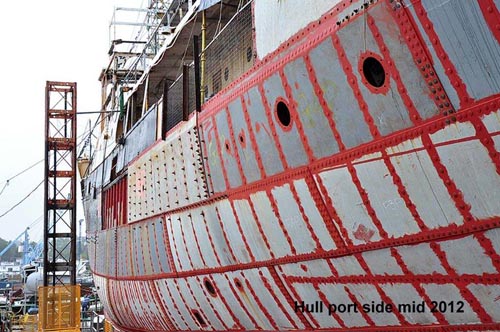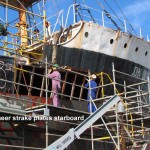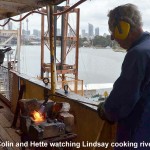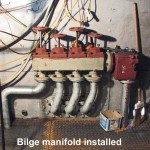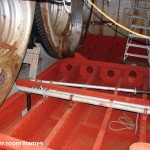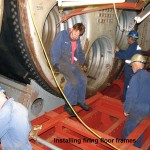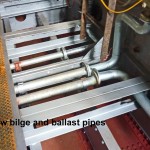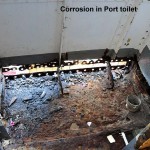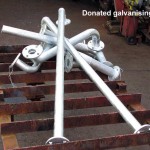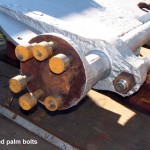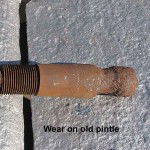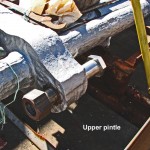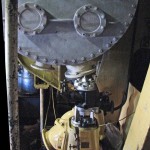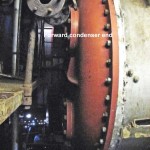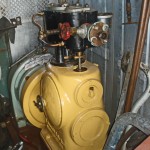John Oxley Restoration
Update July 2012
John Oxley Project 10 years on
It is 10 years since Sydney Heritage Fleet volunteers cut an access hole in the starboard side hull plates, erected some stairs and started cutting out and replicating steel work. Since then, so much has been achieved.
The extraordinary progress to date is the direct result of the tireless and persistent work of the restoration team and the long term support of supporters and sponsors.
The progress of the project is best evaluated through the coloured hull plate expansion diagram that is regularly prepared by Hette Mollema. The current diagram shows a particular milestone with the last port side sheer strake plate G-10 port in place and riveted.
More positives
Volunteering – is a chance to use existing skills and learn new ones. It is also an opportunity to forming friendships plus the social contact between like-minded people. The project is enjoyable to attend without the commercial pressure of the normal work environment. The workforce is engaged, physically and mentally active and enjoying each other’s company.
Youth training – apprentices in metal fabrication and more recently a shipwright have ben vital to the restoration and there are now quite a few skilled tradies in the community as a result of our project.
Efficiencies in expenditure and utilisation – all purchases are carefully considered and when materials are used, nothing is wasted – even scraps of steel plate are used to make pipe flanges and for training welders.
All this is in addition to the primary purpose – value to the community of preserving out maritime past and preserving the skills needed to restore, operate and maintain heritage objects.
Hull
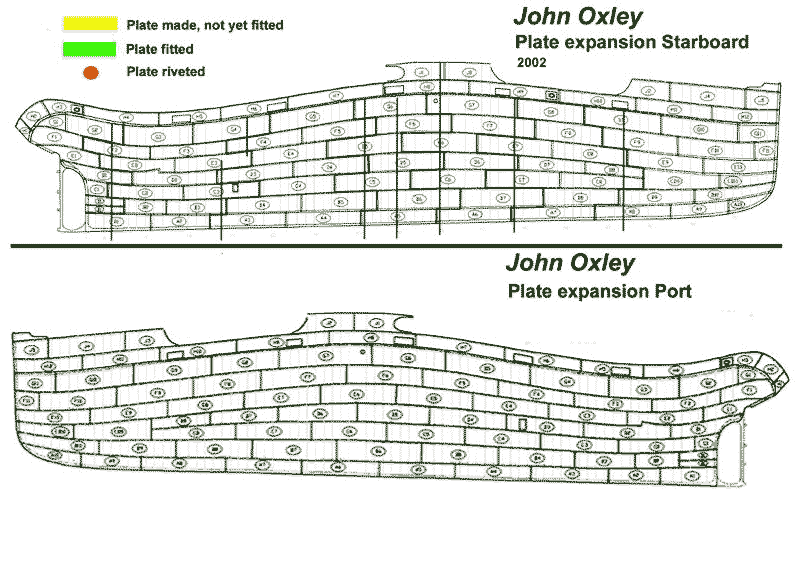 Hull plating – Milestone – The last port side sheer strake hull plate has been fitted and riveted. Only 3 more plates to go on the forward starboard side of “G” strake. A number of old plates have been retained, they are marked on the plate expansion drawing.
Hull plating – Milestone – The last port side sheer strake hull plate has been fitted and riveted. Only 3 more plates to go on the forward starboard side of “G” strake. A number of old plates have been retained, they are marked on the plate expansion drawing.
These old plates carry the scars of time but have still sufficient strength for their purpose. They also add a patina of age to the old lady.
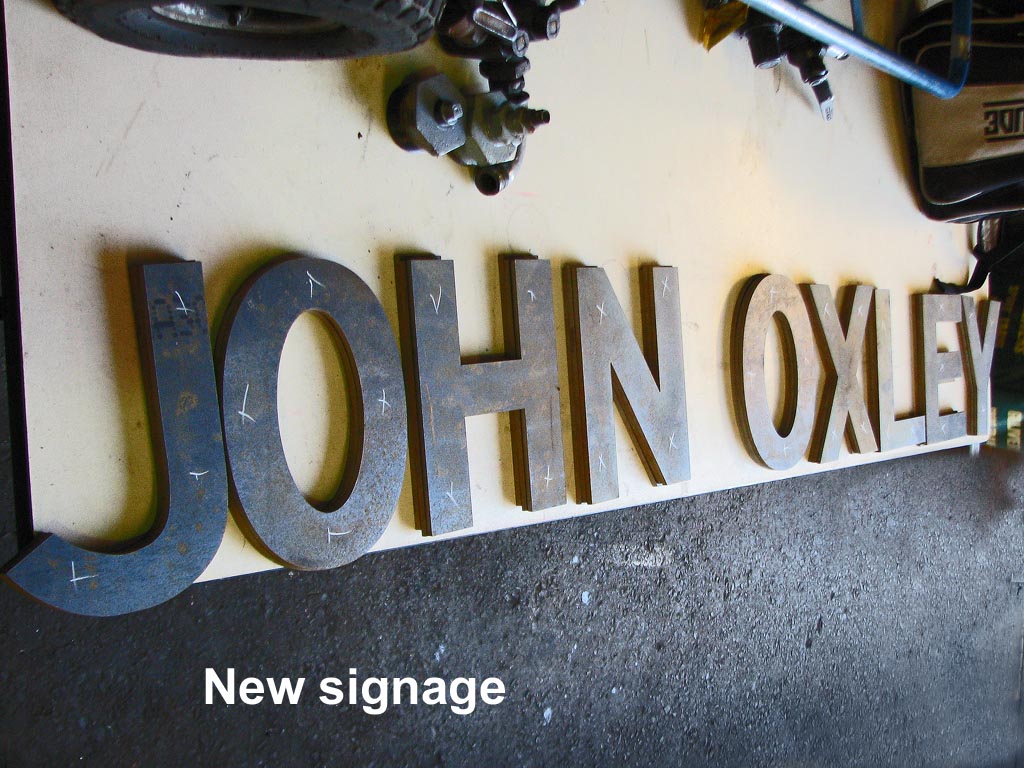 The timing of riveting plate D-4 starboard is dependant on the repair work needed to the starboard boiler, which is located behind it.
The timing of riveting plate D-4 starboard is dependant on the repair work needed to the starboard boiler, which is located behind it.
Prior to fitting new plates, the frames are needle gunned to remove all rust and then coated with a rust neutralising paint finish.
In the images the John Oxley name letters can be seen in sign written form. There are remnants of rivets here, which indicate the original steel letters were once there, but have rust wedged off the hull and fallen away. In a pre-emptive move, new letters 9″ high have been water jet cut in 6 mm. steel plate. They will be drilled for fastenings, galvanised and stored for later installation when these plates are worked on.
The scaffolding is loaned by STA scaffold erection training company who use the project for training scaffolders. After the scaffolding is erected and signed off, it is available for use on John Oxley hull plating.
Boiler room floor – Work has been completed on the firing floor in the boiler room. Support frames have been constructed from recycled steel beams. They were pre-fabricated in the workshop and hoisted into the boiler room. Tread plates have been laid on the beams with cut-outs around piping and gussets.
This needs to be a heavy working platform, for it must support the considerable weight of the furnace fronts if they are removed and resting on the tread plates
Platforms in the engine room are also being worked up. Much of the tread plate work here is complete although temporary plywood “tread plates” are fitted in some places for safety and ease of lifting.
Bilge and ballast piping – Steady progress has been made. The piping, flanges and bends as well as the galvanising was donated by industry sponsors.
The steel piping, bends, flanges, galvanising and transport have also been donated. Fabrication is by volunteers.
Temporary strengthening of the deck margin plates in the forecastle area was necessary to allow removal of the last hull plates forward. The margin plates as seen in the image are in very poor condition and will need replacement.
Machinery
Rudder – Work has started on the final stages of the rudder and hand steering equipment. The rudder has been painted and the rudder pintles were fitted. The upper stock was fitted with bolt fastenings driven into reamed holes. The pintles are a tapered fit, secured with a nut on top. Only the uppermost pintle is in the form of a bolt to keep the rudder in place. The pintles were machined from stainless steel.
Condenser – The condenser pressure tests have been successful and is an indication that the tube bank is satisfactory. Being able to keep the tube bank will save the project many thousands of dollars just in materials.
The satisfactory condenser check also allowed refitting of the condenser onto its cradle. The installation of the circulating pump and its 9″ piping followed by the new build sea valve and water box were dependant on this.
Electricals
While still some time to re-float, we need to plan and start the design and procurement stages for the electrical system. The old electrics were 110 volt DC. Oral history indicated that that the old Sisson steam engine driven dynamo set was overloaded by the amount of extra electrical gear that had been added to John Oxley over the years.
While the Sisson set has been restored and is capable of future work, a 415 volt and 240 volt AC supply is needed to run mandated safety and electronics systems plus lighting, fridges and pumps.
Two generator sets have been donated and will be installed in a main hold enclosure. They will run with minimal supervision. A third generator set, intended for emergency services, has also just been donated. It is in good condition but does need considerable cosmetic work.
Electrical circuit listing and design has commenced and a stock-take of all original fitting is underway.
Equipment Sought
Most of our equipment is ex-industry and was donated because it was commercially out of date – this is fortunate for us as all of our work requirements are 1927 technology and our donated ex-industry machines are quite at home.
The work team wish list includes
| • | Plain drill press – #3 Morse taper |
| • | Horizontal borer – we are always needing to re-bore engine cylinders |
| • | Drills and bridge reamers for 5/8″, ¾” and 1″ rivet work |
| • | Nuts and bolts – all sizes – especially inch sizes |
| • | Air hoses – about 25 mm for mains and smaller sizes for air tools |
| • | 75 mm self priming pumps for bilge service – 2 needed |
| • | 75 mm centrifugal pump for fire service |
| • | 32 mm centrifugal pump for deck wash |
The pumps are needed sooner rather than later as we are fabricating the piping systems. These pumps are in addition to the steam pumps fitted to John Oxley.
If you are able to provide any of these, then please contact Tim at the work site, or call the office on (02) 9298 3888.
To visit the project or help with materials or services, contact our office on (02) 9298 3888 or drop in on the project and ask to see Tim Drinkwater or one of the John Oxley team members.
